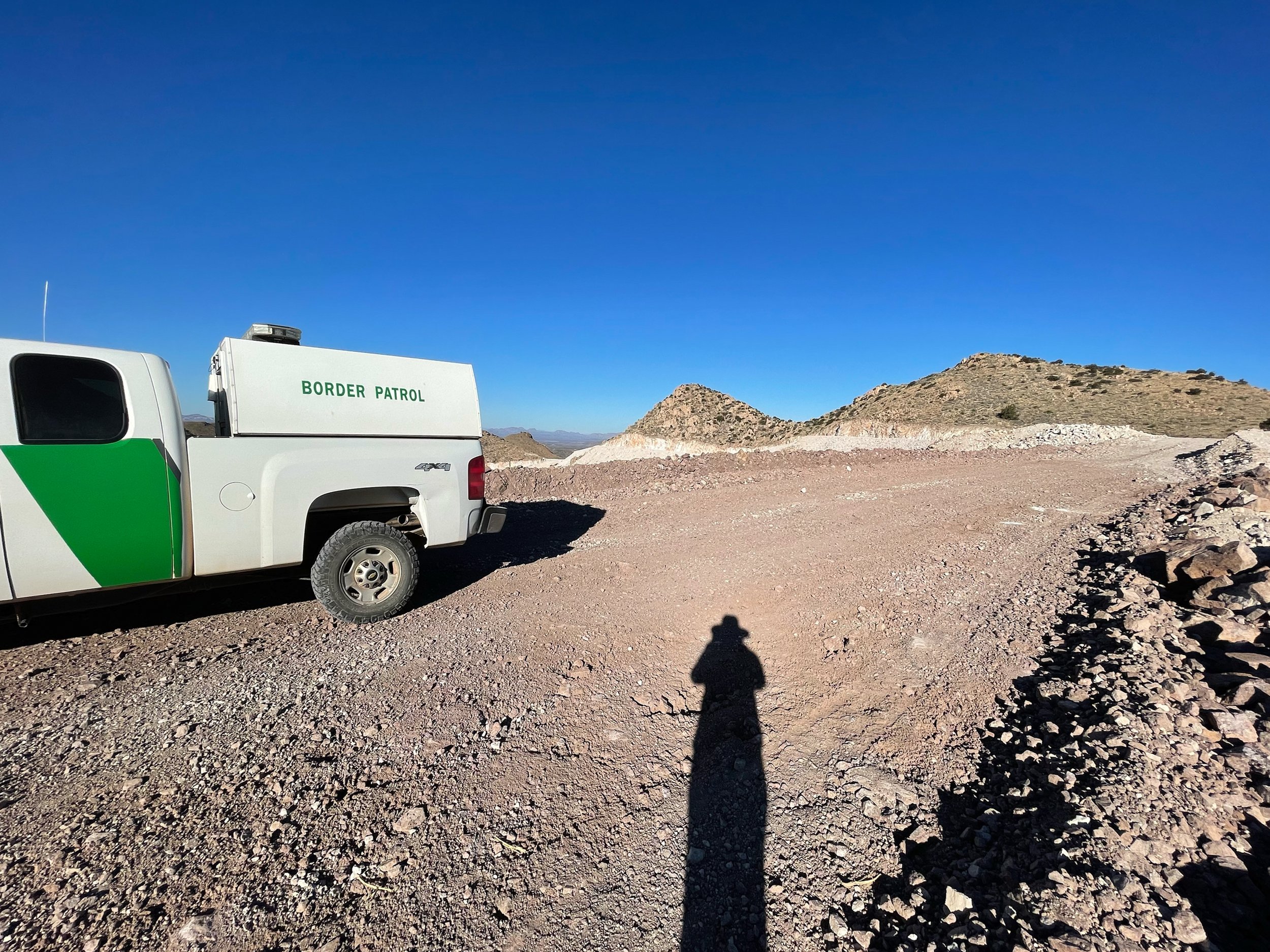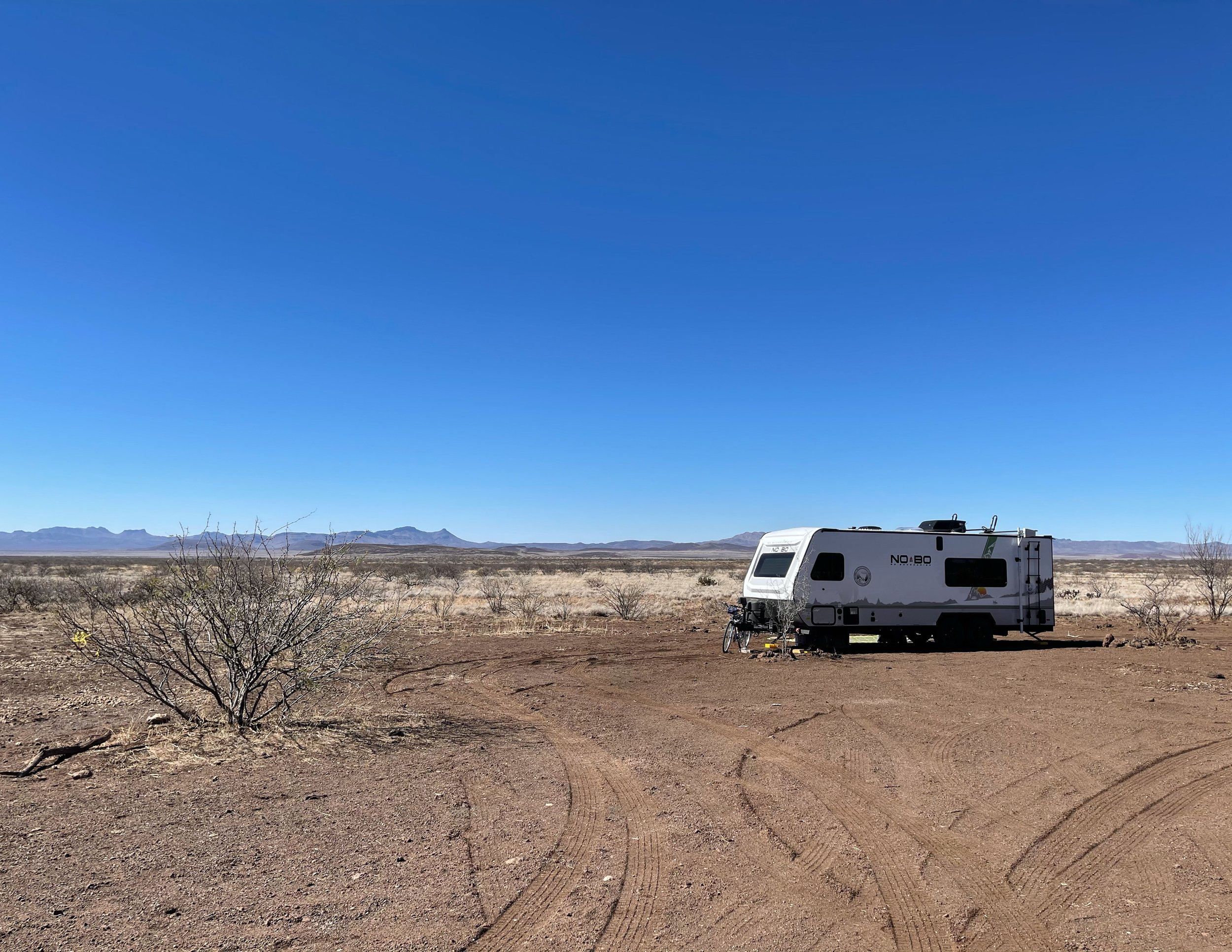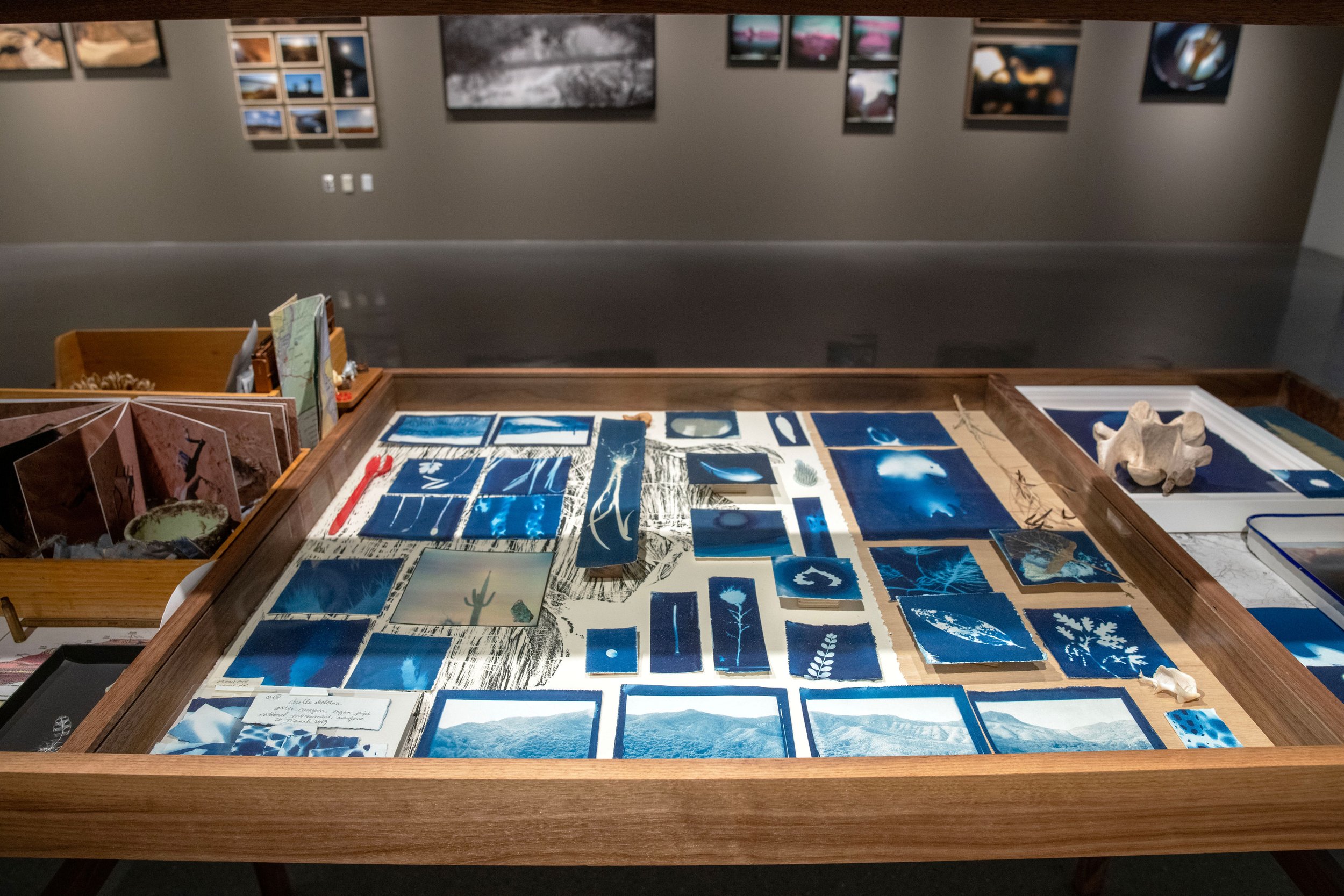




























Installation view of “the story wall”. Each grouping includes images and a handwritten narrative. The following slides show as type.
Photo by the artist

A long and rigorous walk to an ancient sacred dwelling, a profound encounter, a deep marking of existence across human, geological, and celestial time. It is dark on the drive back to camp, and I strike an owl flying low across the road. The islander in me feels the omen of such a killing, and distraught, I weep at the death of a beautiful creature by my careless, human actions. I bring the nightjar home.

In the morning sun I honor its life through the making of a memorial imprint, the body as it is. The wind picks up and the clouds are gathering above the Bears Ears. I point my camera lens to the sky, capturing the promise of rain, or the threat of a torrential desert monsoon. I quickly pack up camp, leaving a moment before the storm arrives, the wind at my back.

2019. The sun sets over a mountain range in México, a strange incarcerated view through the bars of the border wall. It’s December, the night falls early and the temperature is dropping. A coyote is running along the border, looking for a way through. Your timing is good, but the window is closing. I see your shadow of a body slip into the night. The new impenetrable wall is not yet complete, I saw an opening, I photographed it earlier that day. The gap was like a missing tooth, offering an unobstructed view across the border, where the ribs of a dead but still standing saguaro held the horizon, unlike the one on this side of the border plowed down by a bulldozer. Saguaros are protected by state law, they are ancients, living up to 200 years. This one lies dead, pointing to the gap. The allure of the gap beckons, like the feeling when crossing a high bridge, the emptiness pulling you to plummet off the edge. Your timing is good, I hope you find your way home tonight. But what about next winter? Will the gap be closed, completing the 2000+ miles of steel that divides an ecosystem?

2021. I return to Organ Pipe Cactus National Monument and travel the length of the wall from the west at Puerto Blanco to the east where it meets the Tohono O’odham Nation. The gap is closed. I am at Quitobaquito Spring assessing the water level. So much regional water was used to mix tons of concrete to construct the border wall. It’s February and the first rains of the Sonoran winter have fallen. The new border patrol road of dirt and gravel is already slumping from erosion, the ditches thick with drying mud. Things are already falling apart, I think, when I see the tracks. I stop cold, frozen by the pang in my heart and the grip in my chest, imagining you on the wrong side, a family divided. I stare at the false line, a blade severing the grey sky. A land divided. A world divided.

It’s early morning as I leave camp for the arduous journey into Chaco Canyon. A beautiful bluebird is perched on a fencepost. I pull over and peer at it through my monocular, attempting to make a picture of it through the magnified lens, one of my favorite things to do lately. I have wanted to visit Chaco Canyon ever since I can remember, and despite living in New Mexico, Arizona and Colorado, I have never been. Driving through the greater Chaco landscape I think about the “Fracking Reality Tour” led by Daniel Tso, Navajo Nation council member. I want to go on a tour, but there are none as we are in a pandemic. So I think of oil drilling, its effect on respiratory health, and the disproportionate impact of COVID-19 on the Diné. I see a tuft of fur blowing in the wind and pull over. Two executed puppies lie just off the road next to a discarded pair of blue rubber gloves. I take photographs, and feel sick for doing so. I am sorry, I say, and drive on. After many miles on the bumpy, dusty road, my mind calms and I arrive at a site of ancestral Puebloan culture where countless people gathered over a thousand years ago. The Great Houses are vast, with structures oriented towards the sun, the moon, and celestial events. I feel the power of this place.

The sun beats down intensely, so I slip away into an underground space, where my body casts a soft shadow on the earthen wall, like a ghost. The day is waning, and the park closing, so I head out, passing a herd of elk laying in a meadow. The deeply rutted road jostles everything, it’s like I’m tumbling away from the canyon. I finally reach the pavement and turn west towards the sun that has dipped behind the mountains. It happens so fast, I don’t even remember seeing it until a small form is rolling down the road in my rearview mirror. A western bluebird. I cradle her in my hands, but her neck is broken. She is already dead. Maybe she was flying home for the evening, maybe to the place I admired a male western bluebird this very morning. Maybe to her mate. The world is violent. We are ghosts.

In intense moments we often think of the most absurd things. This afternoon I am tucked inside with 33mph wind gusts shaking the MRS. The whistling and howling makes it hard to think, so I choose the simple task of cataloguing a pile of cyanotypes.

I look at this one and am transported to a cloudless, dry day, barely a few weeks ago. At Cabeza Prieta, I haven’t seen a soul for miles, and the aptly named El Camino del Diablo grows narrower, more rutted and with deeper and deeper sand, the thorny branches of mesquite hemming me in on the sides. I think of the history of this road, and the many who have perished here over time. I finally find a place to turn around, and after some time, find a spot that seems somewhat close to the border wall. I’d like to drive closer, but the “road closed” sign deters me, as I don’t relish the idea of a citation or confrontation with the law. I pack my backpack and begin walking. I think, it will take me thirty minutes to get there. Like a mirage, the wall recedes further and further away and I realize after 20 minutes that I did not replenish the water bladder before I left. As I near the wall, I begin to follow a path of peanut shells, wondering who ate them and discarded the shells, a contractor, an asylum seeker, a border patrol agent? Seeing the peanut shells in turn spark a string of random memories-boiling peanuts with my grandmother, my dad’s love of peanuts and my mom’s exasperation at his snacking habits. I pick up a shell and am transported, without choice, to an afternoon some years ago to Marina Abramović’s “The Cleaner”, a retrospect exhibition. I wept many times that day, but I especially remember both the heartache and joy I felt viewing “cloud with its shadow”.

My conscious returns to the present; I feel the hostility of this place, the sun beating down, the screeching of a single hawk carried on the wind, my lips nearly glued together by dehydration. Just looking at the shells and imagining their salty contents are making me thirsty. Why was the little peanut pinned to the pristine white walls of the gallery so delightful, but so very sad today? I pull out a leftover scrap of coated cyanotype paper and place a shell on the paper and angle it into the sun while standing in a real human crisis. There’s no one to talk to, but I say anyways, what a sweet peanut cloud you are, offering shade to tiny creatures. Then I walk closer to the wall. It’s strange to finally reach the mammoth seemingly impassable 30-foot steel barricade and be grateful for the striped shade it offers. Contradictions. I unpack the drone and we fly west, then east, then west again until the sun begins to descend and it is time to start walking back.

The hawk begins to screech again, and I can see it poised on top of the same saguaro it screeched from on the way in, when I attempted to take a photograph through the binoculars as I had never seen a hawk open its wings quite like that, like a turkey vulture after the rain. The bird is a sign I am close to the road, and the truck, which means water. I look at my phone. Five miles. I lick my parched lips, hoping I got a good image from the day’s debacle. Cataloguing this tiny print today, I think maybe it is the one.

I can feel an infection raging in my body, but I’ve already seen healthcare professionals twice, who assure me I am fine. The day I leave Madison, I spend the early morning in the emergency department, insisting to be diagnosed by a physician, but he sends me away, arrogantly suggesting that my legitimate phone visit with an MD the night before was inconsequential, and shaming me for asking for what he calls “the gold standard”, as if I was taking up time and space in an university hospital that belonged to someone else. He sends me away, untreated. My brother-in-law is accompanying me as the trailer-driving trainer the first leg of the trip, and we go to get COVID-19 tests. As we leave, we run into dear friends Adriana and Barbara which improves my mood. Leaving town, the snow fall intensifies, and the sky darkens as we drive into a wintry blizzard. Each day I feel sicker as we head south. On January 6, we are almost to Las Cruces, New México, where I used to live, and I say, let’s stop at White Sands, a National Monument that was on a list of public land under review for deregulation under the former Trump Administration. I bring Cub out to enjoy the view and take a snapshot of us to send to Adriana and Barbara, who know this place well. I can’t take my eyes off the news, they write back. The next time I catch a bar of signal I dive in. David had warned me, it is going to be bad, but I dismissed him as overreactive. He could not have been more right. By the time we reach Tucson, my fever is high, and I am weak. My brother-in-law says, you need to go to a hospital. Tucson is experiencing the highest COVID-19 death rates in the country, and people are dying in emergency waiting rooms. My friends find a private hospital, one that I can be seen at quickly, if I have the cash. The doctor is kind. After just a minutes, they have me hooked up to an IV, immediately giving me “the gold standard” which detects a MRSA infection on the verge of sepsis. He slices into my skin to drain the infection. I think about all the people who have suffered due to healthcare inequity and racial disparity, and especially of Dr. Susan Moore, a black doctor who publicly posted about not being treated fairly, who died just a few weeks ago from COVID-19. As the antibiotics drip into my veins, I am glued to the TV, which is streaming footage from the attack on the US Capitol. I’m shocked, dizzy and nauseous. My trip has just begun.

I leave before dawn, walking towards the waning crescent moon, a golden sliver hovering over the edge of the thirty-foot wall like a beacon. When I cannot walk any further, I turn east and follow the boundary between the United States and México. I know it won’t be long. Behind me are two tiny white lights in the distance. The sky is beginning to lighten before headlights are shining on me and a voice speaks in Spanish, where are you going? I answer, to see the sunrise, but my backpack is heavy, and the road is rough. He switches to English, I thought you were someone else and was going to offer you a ride back. I think, who else could I be, and back where? Since the invocation of Title 42 at the beginning of the pandemic, agents can expel migrants instead of allowing them to seek asylum. They put them on a bus and take them far from where they were encountered. Want to give me a ride? I ask, I want to get to the top of this hill before sunrise. He pauses and then says, okay, but you have put on a mask. I can’t believe my good luck and hop in the passenger side. We aren’t but two minutes into the drive when we agree that the wall is not the solution. The problem is systemic, he offers. I ask, have you been to where the contractors blew off half a mountain? No, but I see them speeding by in their work trucks. His tone confirms the tension I have been picking up on. That is where I am headed, want to go there?

We arrive just as the sun is rising over the ridge and I fly the drone up and down the canyon. I take out my field camera and set it up on tripod. He tells me he took photography classes and really liked printing in the darkroom. It must have been in El Paso, where he is from a family of teachers and law enforcement officers. I tell him I teach film photography and darkroom classes and picture him as a student, a civilian. He leaves me there, but comes back later to check in. I know the road goes on a few more miles through this rugged landscape, where there had not been a wall, or road, before. Do you want to go to the end of the road? There a bulldozer has pushed a berm of rocks to the top of a steep slope, marking the end of the road. He walks to the edge and gazes out. We look quietly together at the expansive desert, the first view of an unscarred landscape.

I’ve been out here for about a week. On the second day a border patrol truck follows me for miles back to camp. We exit our vehicles and stand face to face. I was just seeing what you are doing out here, he says. Well, I have a pretty nice camp, but don’t have any firewood. As he departs, he says, you can call me Agent Brewoo. You can call me Professor Jones, and the next time you visit, please bring firewood, and he finally cracks a smile. I feel a little bit better having another person of color in the field. The nearest town is thirty miles down a dirt road. Here the Sonoran Desert is flat, the foliage sparse, and my camp is exposed to the road. It is true that I have felt spooked. It’s been a month since the storming of the US Capitol, and two weeks since President Biden signed an executive order temporarily pausing border wall construction. Hostility and xenophobia are palpable. One day I’m headed towards the New México side of Guadalupe Canyon. I stop before turning onto the road to doublecheck that I brought the map, when I hear the crunching of tires on gravel. I look up to see four white men, clad in camo, in a big white truck with a gun rack. They slow down next to me. I’m alarmed but raise my hand and wave. They stare back at me coldly and do not wave back. The hair stands up on the back of my neck. Vigilantes. They move past me, kicking up dust as they circle my camp, and then continue down the dirt track. I’ve followed that track, it does not seem to lead anywhere.

I go back to my camp and scoop up Cub, extra food and water, and the rest of the gear. I grab the bear spray which is next to the fire extinguisher. I can’t help but think about the Asian American family ambushed, surrounded by trucks, and threatened while camping last summer. I check all the locks and think, locks won’t matter when there is a fire. We head up and over the Peloncillo Mountains where I search for easement into the canyon, but all the roads are blocked. I see a U.S Customs and Border Protection vehicle, also a big white truck, and pull up. I ask about the blocked roads. The two agents share information about the geography and the private public tension around the border. I ask if they have seen the mountains that were blown up with dynamite to construct the new wall. No. I ask them, how did you become border patrol agents? It pays well, one of them says, and I learn they are both from Lordsburg, a predominately Latinx community. They are surprised when I say I’ve been there. I lived in Las Cruces, I tell them, which they laughingly call the big city. I also remember there was a Japanese American Incarceration Camp in Lordsburg during WWII, but I don’t bring it up. Hey, I want to tell you about the men in my camp today. It’s not hunting season, is it? They shake their heads. They give me a card with their phone number. Call us if you run into trouble or need help.

installation view
postcards, cyanotypes, maps, artifacts, written notes, ephemera

toned cyanotype contact prints of 4×5 film negatives